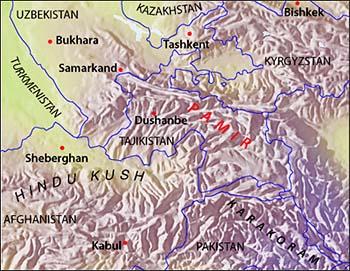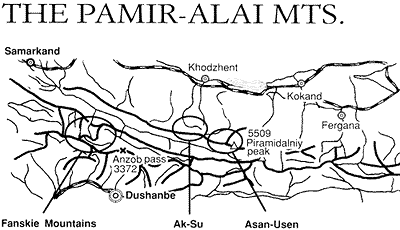| Getting
there The best place
to depart from for Pamir Alay is Tashkent, the capital of Uzbekistan. Lufthansa
(from Frankfurt) and Turkish Airlines (via Istanbul) offer direct flights from
Europe. If you trust the airline companies of the post Soviet era, then flights
via Moscow can be cheaper: the cheapest flight from Moscow to Tashkent costs around
US$ 350.
A visa is necessary for both Tajikistan and Kirghistan.

|
 There are two ways to get to the
Pamir Alay valleys from Tashkent. The fast option is to fly by helicopter (US$
2000-2500 return, max. capacity 30 people). Alternatively, drive overland along
the fascinating route through the villages in Tajikistan and Kirghistan (2 days)
and then continue on foot for a further 2 days, accompanied by Kirghisi shepherds
and their pack horses. This second option can be organised with the travel agency
mentioned above.
There are two ways to get to the
Pamir Alay valleys from Tashkent. The fast option is to fly by helicopter (US$
2000-2500 return, max. capacity 30 people). Alternatively, drive overland along
the fascinating route through the villages in Tajikistan and Kirghistan (2 days)
and then continue on foot for a further 2 days, accompanied by Kirghisi shepherds
and their pack horses. This second option can be organised with the travel agency
mentioned above.
A bloody civil war was raged in Tajikistan until
a few years ago and at present a precarious armistice holds out. Apart from the
frequent police checks, the journey through Tajikistan to the Pamir Alay tends
to be free of problems. Look after all documents which must be consigned or compiled
at customs offices, and be particularly careful when declaring foreign currency.
There are no amenities in the Pamir Alay valleys. A well stocked base-camp,
with all the gear necessary for an expedition, is therefore indispensable. The
"agents" charge US$ 40-60 per person/day, but it may be worth trying
to barter. Included in this price is the transport overland from Tashkent, the
provisions and all the costs associated with the running of a base-camp, from
the kitchen to the sauna. The cost/person varies according to the size of the
expedition (the larger the expedition, the lower the cost). Although the organisation
covers all the logistics, we nevertheless recommend you take your own tents, for
comfort's sake.
The climate and the people As
Central Asia is an enormous continent, its climate is not influenced greatly by
weather changes from the sea. The temperature range between night and day and
summer and winter is fairly small, and this area does not receive much rainfall.
Summer can be extremely dry; July and August are characterised by clear, cloudless
skies and alpine temperatures, making these the best months for climbing. The
local people are generally very welcoming and so too are the Kirghisi shepherds
who live high up in the valleys. Of Mongolian origin, they have interpreted the
Muslim faith in their own "liberal" way; women are not obliged to wear
veils and they have a high status, contributing actively to the family life. Their
way of living is connected more to the unwritten laws of nature than to the rules
laid down by their religion. Their livestock, the yaks, are free to pasture in
the valleys in summer. These and hunted marmots constitute their diet, in winter
too. Their genuine hospitality is exceptional and visitors arouse great curiosity,
especially in women and young children. "Sovietisation"
is scarcely evident in the mountain villages, but it has left behind some traces
in the cities; apart from statues of Lenin and other obvious external signs, it
is clear that these people are in the middle of an uncertain period of change.
They are struggling not so much with economic difficulties, but with the substitution
of the old ruling class, of Russian origin, with the new local bureaucracy. Hopelessly
disorganised and at times both arrogant and corrupt, the new governing body still
has effective police powers. This is one of the most evident and worrying signs
of their difficult transitional phase. |

